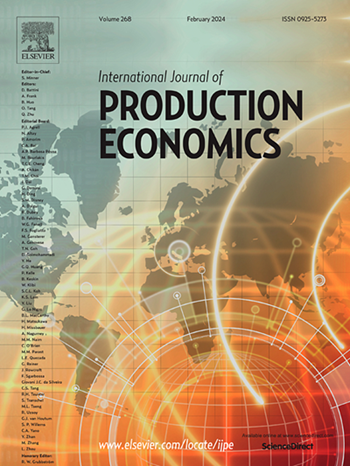A novel robust optimization approach for supply chain resilience: The role of flexibility and collaboration
IF 10
1区 工程技术
Q1 ENGINEERING, INDUSTRIAL
引用次数: 0
Abstract
Supply chains are increasingly vulnerable to disruptive events that impair performance and stability. Despite research on supply chain resilience, a significant gap remains in risk management approaches on how to simultaneously minimize expected costs and control extreme cost variations. Existing methods neglect to narrow the gap between worst-case and best-case outcomes and to quantify the economic benefit of enhanced information in decision-making under uncertainty. This gap underscores the need for an integrated robust optimization framework that balances expected cost and risk while incorporating the assessment of novel digital technologies. In response, this study proposes a two-stage stochastic mixed-integer nonlinear programming (MINLP) model that introduces two new metrics: Evolutionary Modified Conditional Value at Risk (EMCVaR) and the Information Impact Metric (IIM). EMCVaR unifies tail risk, solution variance, and model infeasibility into a single measure, yielding a controllable and predictable cost range, while IIM quantifies the economic benefit derived from the data-driven decision support system. Moreover, our model incorporates digital technologies, such as advanced screening, predictive analytics, and real-time digital monitoring, to enhance supply chain flexibility and collaboration. Our computational analysis demonstrates that diversified resilience strategies reduce both expected and worst-case costs, decrease cost variability by up to 15 %, and narrow the gap between extreme outcomes by over 30 %. From a managerial perspective, the study recommends adopting EMCVaR as a risk-budget to bound cost volatility, employing IIM to prioritize digital-technology investments that accelerate recovery, and formalizing backup-capacity and spot-market clauses with key suppliers, an integrated strategy shown to reduce worst-case disruption costs by more than 30 % while limiting routine cost variability to roughly 7 %.
供应链弹性的一种新的鲁棒优化方法:灵活性和协作的作用
供应链越来越容易受到影响绩效和稳定性的破坏性事件的影响。尽管对供应链弹性进行了研究,但在如何同时最小化预期成本和控制极端成本变化的风险管理方法方面仍然存在重大差距。现有方法忽略了缩小最坏情况和最佳情况结果之间的差距,以及量化不确定情况下决策中增强信息的经济效益。这一差距强调了需要一个集成的强大的优化框架,以平衡预期的成本和风险,同时纳入对新型数字技术的评估。为此,本研究提出了一种两阶段随机混合整数非线性规划(MINLP)模型,该模型引入了两个新度量:进化修正条件风险值(EMCVaR)和信息影响度量(IIM)。EMCVaR将尾部风险、解决方案方差和模型不可行性统一为一个度量,产生可控和可预测的成本范围,而IIM量化了数据驱动的决策支持系统带来的经济效益。此外,我们的模型结合了数字技术,如先进的筛选、预测分析和实时数字监控,以增强供应链的灵活性和协作。我们的计算分析表明,多样化的弹性策略可以降低预期成本和最坏情况成本,将成本可变性降低15%,并将极端结果之间的差距缩小30%以上。从管理角度来看,该研究建议采用EMCVaR作为控制成本波动的风险预算,采用IIM来优先考虑加速恢复的数字技术投资,并与主要供应商正式制定备用产能和现货市场条款,这一综合战略表明,最坏情况下的中断成本可降低30%以上,同时将常规成本波动限制在7%左右。
本文章由计算机程序翻译,如有差异,请以英文原文为准。
求助全文
约1分钟内获得全文
求助全文
来源期刊
CiteScore
21.40
自引率
7.50%
发文量
266
审稿时长
52 days
期刊介绍:
The International Journal of Production Economics focuses on the interface between engineering and management. It covers all aspects of manufacturing and process industries, as well as production in general. The journal is interdisciplinary, considering activities throughout the product life cycle and material flow cycle. It aims to disseminate knowledge for improving industrial practice and strengthening the theoretical base for decision making. The journal serves as a forum for exchanging ideas and presenting new developments in theory and application, combining academic standards with practical value for industrial applications.

 求助内容:
求助内容: 应助结果提醒方式:
应助结果提醒方式:


